My Child on Atropine for 2 Years
Health December 13th, 2013
No one would like to be on medication for long period of time, let alone a 10 year old boy.
Ever since Kitkit started wearing spectacles years ago, I noticed that he gives the optometrist (regardless from which optical shop) a very hard time, whenever he visits the optical shop. Watching the optometrist adding higher power lens to the frame, during testing and yet Kitkit still continued to give incorrect answers to what he sees on the wall, has become a growing concern.
Two weeks ago, we went to Nanyang Optical and tried to test his myopia again. After testing for a very long time, with Kitkit giving the same problem, the optometrist suggested that we visit Singapore National Eye Centre (SNEC) for a thorough eye check.
When I called SNEC right after we left Nanyang Optical, we were given a choice to decide if we would want to go for the subsidised rate or not.
In order to get the subsidised rate, we would need to go to a Polyclinic first, get a referral letter from the doctor there, before we could go to SNEC. However, though it is a fraction off the price, but the next available date (for patients on subsidised rate) would be in January!!!
When it comes to health issues, we prefer NOT to procrastinate. We chose NOT to wait and opt to for the NON-Subsidised rate.
Hence, WITHOUT subsidies, we were given priority and the next available date to meet the eye doctor in SNEC was the following day after our call. *thumbs up*
 Once again, the Optometrist at SNEC also had a hard time finding Kitkit’s exact eye power. After hearing from the Optometrist, the eye doctor at SNEC believed that Kitkit has extremely active eye muscles, hence every blink of the eye gives a different refraction test result.
Once again, the Optometrist at SNEC also had a hard time finding Kitkit’s exact eye power. After hearing from the Optometrist, the eye doctor at SNEC believed that Kitkit has extremely active eye muscles, hence every blink of the eye gives a different refraction test result.
So the eye doctor suggested special eyedrops for my son before the Optometrist could perform another eye test again.
These special eyedrops will help to paralyse the eye muscles, hence the test will be more accurate.
This special eyedrop treatment is called Cycloplegic Refraction.
In total, the nurses will drip 3 different eyedrops separated by 3 occasions, to fully relax the eye muscles.
The thought of one drop already made my son freaked out.
Imagine his response when he heard he had to have 3 drips in each eye and 6 drips in total!
His heart was racing on the F1 track!
It was a torture for Kitkit during those few minutes sitting outside the room, waiting for his turn to get the special eyedrops into his eyes.
Kitkit started crying.
He was very scared.
He’s negative mind started to imagine the worst of the worst.
Our words of comfort fell onto deaf ears.
He just kept sobbing away.
The nurses told us that he needs to stop crying first before they could drip the special eyedrops for him or else the tears will wash the eyedrops out of his eyes.
While my firstborn tried to calm his nerves and stop his tears, precious time drifted by.
Kitkit’s vision became blurred and his pupils were dilated after the first drip.
Before the Cycloplegic Refraction was done, I had to sign a form, something like an indemnity form cum consent form.
Thus I was already aware that Kitkit’s eyes will have such effects.
The effects of the special eyedrops will last for at least half a day to a maximum of 3 days, depending on individual. So for the next 3 days I had to pay extra attention to my child.
Should he experience any discomfort, blurred vision and eye pain associated with headaches and vomiting or if the effect of the Cycloplegic Refraction lasts more than 3 days, I will have to contact SNEC immediately.
After the last eyedrop was dripped into Kitkit’s eyes, we had to sit around and wait for more than 30mins for the eye muscles to be in a fully relaxed state before entering the Optometrist room again for the 2nd test.
During this time when his vision was blurred, Kitkit was so bored sitting around and could not do much; I had to be his eyes…..and information centre….
“Mummy, what is that red thing?”
“Mummy, what is that thing moving over there?”
“Mummy, where is Papa and Binbin?”
etc….
It was a great sigh of relief when the Optometrist called Kitkit’s name after the long wait.
And the result of the 2nd test with the eye muscles fully relaxed was:
After the Optometrist completed the test, we waited outside another room to wait for the eye doctor to call for Kitkit for the final consultation.
Unknowingly, we had already spent 2 hours in SNEC, going in and out of different rooms and sitting on the chairs….waiting….!
The kids were extremely BORED, but well behaved! Thank goodness! *phew*
Lesson learned, never visit SNEC during school holidays!
The eye doctor said that Kitkit’s myopia progression was considered fast over the span of 1 year.
See Kitkit’s refraction test results last year:
Thus the eye doctor suggested Atropine for Kitkit for the next 2 years.
Yes, you heard me right, 1 drip EVERY NIGHT, for 2 years.
You can imagine Kitkit’s immediate reaction!
Yup, his jaws dropped and his eyes popped!
*sigh*
Atropine eyedrops are used to retard myopia progression. The eye doctor suggested to use Atropine because Kitkit’s myopia increases rapidly despite my child had been observing healthy eye habits. I limit my kids to 30 mins on electronic devices with a timer beside them, have daily outdoor activities with them, made sure that they relax their eyes after 30-40mins of near work, ensure that they do not slouch when on the couch, so that the height of the TV screen is at their eye level or lower.
Despite all those efforts made, Kitkit’s myopia progression was still too fast. According to the researchers, myopia can develop as early as kindergarten age and can progress rapidly during Primary School years. However, myopia progression typically slows down during the teenage years and stabilizes by early adulthood.
Atropine eyedrop is NOT a new or experimental drug. Eye doctors have been using it for many years in the treatment of a variety of eye conditions found in children such as lazy eye and squint. In fact, Atropine has been prescribed for myopia in children since the 1960s.
Kitkti was prescribed with the Low-Dose (0.01%) Atropine. Research showed that this low-dose Atropine has proven to be effective in slowing myopia by 50-60% over a 2 year period, and with very little side-effects. The effect of low-dose Atropine appears to be better in the second than first year. As low-dose Atropine causes only minimal increase in pupil size, thus will NOT allow as much light into the eye, causing glare and blurring of near vision, as compared to the higher-dose (1.0%) Atropine.
As such, low-dose Atropine is safer and more comfortable eyedrop to use than high-dose atropine. However, some myopia progression may still occur, and if this is still rapid, then the eye doctor may need to prescribe higher-dose of Atropine. I HOPE THIS DAY will NEVER come!
The decision to use Atropine is therefore a balance between the known short-term benefits of reduction in myopia progression and the as yet known risk of long-term ocular problems from the use of Atropine. By controlling the progression of myopia in children will thereby decrease the risk of blinding myopia-related eye problems in future. The long-term risks of low-dose Atropine, however, are expected to be less than higher-dose Atropine.
We accepted the eye doctor’s suggestion because I do NOT want Kitkit to ever reach MY HIGH MYOPIA of 1000.
Hhhhmmmmmmm…. It is REALLY a nusiance during teenage years when there are so much outdoor fun and activities that is more enjoyable without the thick and heavy spectacle lens! I went through that and I do not want my son to go through the same “suffering“.
The damage for those 2 over hours in SNEC was $149.80, WITHOUT including the cost of the tiny bottle of low-dose Atropine.
Atropine is NOT a medication which you can buy off the shelf.
An order NEED to be placed.
Our order was placed on 22nd November 2013, the day we visited SNEC.
The low-dose Atropine arrived on 25th November 2013.
Due to the contents inside the low-dose Atropine, it expires in 5 weeks.
Thus, it is NOT Possible to collect 2 years supply at one go.
So we could collect 1 bottle only, each month.
Meaning, for the next 2 years, I will need to set an alarm to remind myself to go to SNEC on the 26th of every month to collect Kitkit’s small bottle of low-dose Atropine. Forgetfulness is not acceptable in this case as he needs to be on it EVERY NIGHT before he sleeps; as there will NOT be any reminder phone-call from SNEC. *pout*
We have started KitKit on the low-dose Atropine on 26th. The first few nights were horrible. He’s FEAR of having water in his eyes was overwhelming.
*sigh* It was a daily struggle for us, every night, for the first week; but after that, he became more cooperative. Now, he is handling this night routine really well. *thumbs up*
Kitkit said that the low-dose Atropine did NOT cause any pain or itch to his eyes, nor did it give him headaches or giddiness or any sort.
*Double Thumbs UP*
So far so good!
*grin*
The cost of EACH bottle of low-dose Atropine is $16 inclusive of GST.
Payment of $16 has to be made upon placing the order for the following month.
Expected cost (provided there is no change to the cost of Atropine and GST): $16 x 24months = $384
On top of that, Kitkit was scheduled to go to SNEC often for regular checkup, to check how well his eyes are responding to the low-dose Atropine and his myopia progression.
Those checkups = money going out too.
*sigh*
The next visit to SNEC has been scheduled in January 2014.
To protect his eyes further, the eye doctor wants Kitkit to wear PHOTOCHROMIC lens for his new pair of spectacles.
As his pupils will be slightly dilated, after using the low-dose Atropine, letting in more light and harmful UV rays, Photochromic lens help to act as a filter.
So expect to see Kitkit wearing his 6th pair of spectacles (since 2010) in the next blog post…..
My Child on Atropine for 2 Years

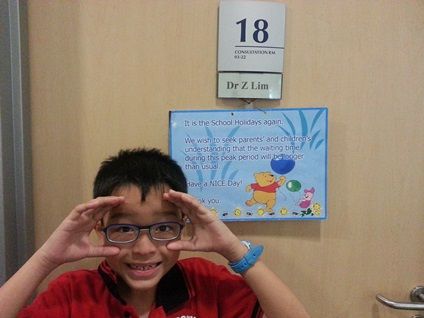
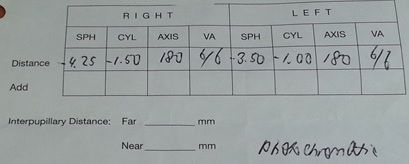
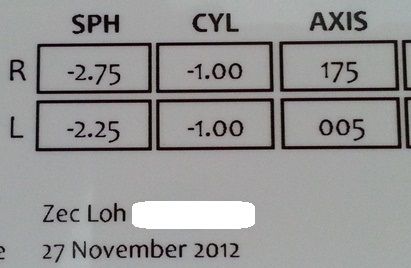

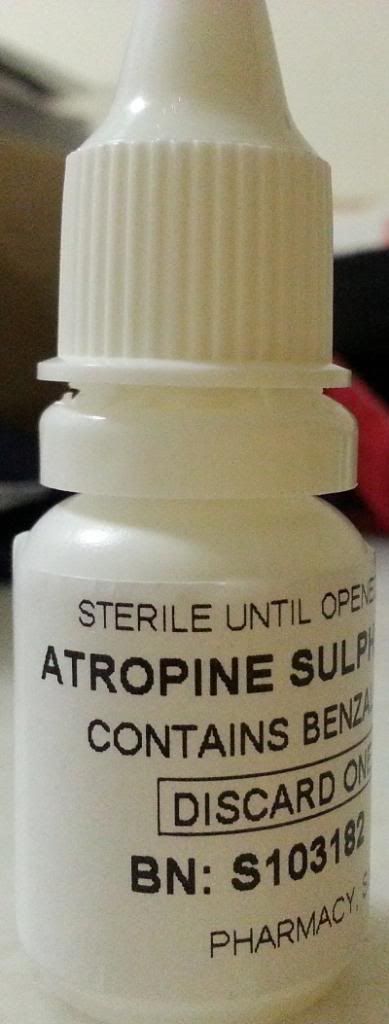
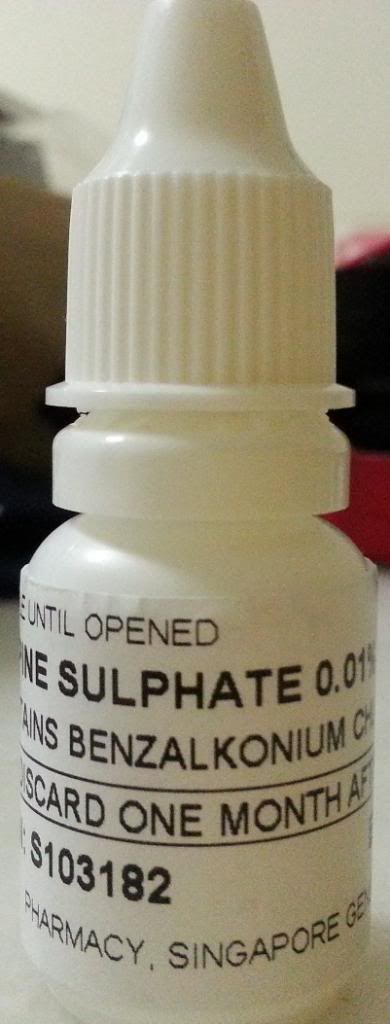
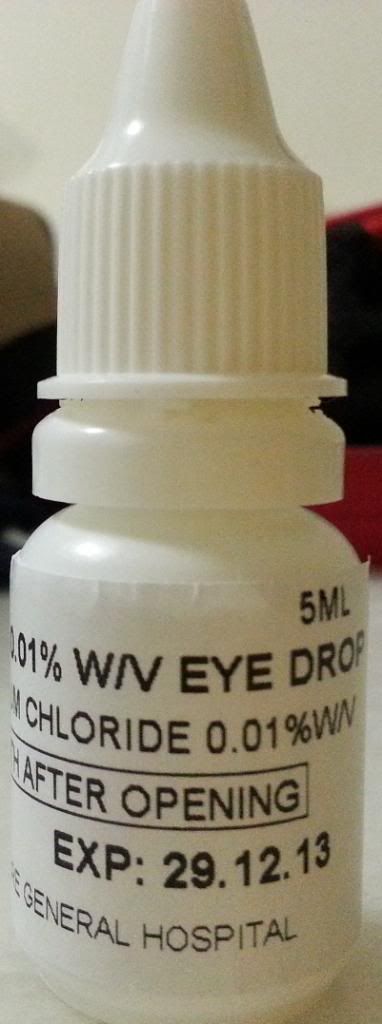




December 18th, 2013 at 3:10 am
Hi ,
I read your wonderful article about the low dose atropine drops.
My son is also currently on the low dose but we live in the US. So I have to get the special order each time. Please keep us updated with your son’s eye condition and the power each time you go to a test. This will help us a lot ! thanks so much for spending time to document your story.
December 18th, 2013 at 7:41 pm
Hi Jay,
I have the intention of doing the updates too.
Feeling apprehensive and excited at the same time over the outcome of the next eye check….
*fingers crossed*
March 3rd, 2014 at 1:48 pm
Hi,
Do you how much to make the Photochromic lens? And is it allowed in school since it darken in outdoor?
March 3rd, 2014 at 5:00 pm
Hi Liz,
the price of the Photochromic lens is determined by the degree of the child’s myopia.
So the price varies from one person to another.
The eye doctor wrote a letter to certify that Kitkit needed to wear Photochromic lens and Kitkit brought that letter to school; just in case a teacher questioned him about the ‘darken lens’.
But after wearing for months in school, no teacher came forward and we found out that it is actually very common among his friends.
Thus wearing Photochromic lens is allowed in his school.
If you are worried about this, you can always ask the eye doctor for a letter as a prove, to show the teachers in school.
March 5th, 2014 at 5:32 am
Hi,
Thanks! Do you think we can communicate via email? I would like to ask more on this.
March 5th, 2014 at 11:55 pm
Hi Liz,
sure!
email me at angeline@allaboutyourchild.com
September 29th, 2017 at 4:24 pm
Hi Angeline,
My daughter age 10 is in the similar condition as your son. Doctor advise the same but we are not sure about it. Please could you message me how is you boy after the treatment? It would be a few years by now. We are in a Perth and there is a trial case study provided.
Hope to hear from you.
Regards,
Cindy
March 10th, 2018 at 10:32 pm
Hi Cindy,
extremely sorry for the late response.
So did your girl go through it?
My son went through it for 1st year and didn’t continue for the 2nd year.
Because I didn’t see an increase in his degree anymore.
I was very determined to settle his issue, so I gave him Lutein to drink too.